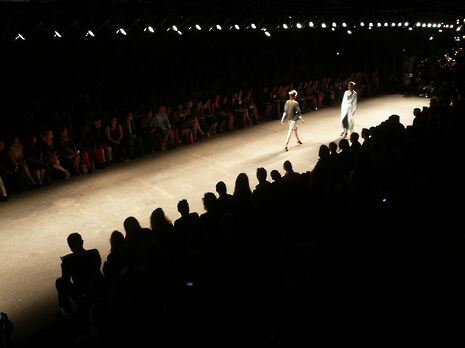The CUCFS model lineup replicates high fashion’s toxic ‘beauty’ standards
Georgie Newson-Errey urges CUCFS to confront the exclusionary beauty standards dictated by high fashion

Earlier this week, the model line-up for the Cambridge University’s annual Charity Fashion Show (CUCFS) was released. CUCFS, now in its fifth year, provides up-and-coming designers with a platform for their work whilst raising money for a range of wonderful charities; it self-describes, rightfully, as ‘a highlight of the academic calendar’. The theme this year is ‘flux’, which refers to practices that involve ‘breaking with traditional norms and rules, allowing for fluidity in fashion’.
However, for an initiative so clearly concerned with the new, the experimental, and the transformative, CUCFS’ casting process seems to be informed by a very conventional idea of beauty. This year’s models are all slim, with strong jawlines and high cheekbones. It is difficult, when scrolling through the line-up, to locate exactly where these ‘traditional norms’ are supposedly being broken.
High fashion’s aversion to venerating or even simply representing more than one particular body type is a well-documented subject. In fact, for anyone even tangentially following the body positivity movement, it feels like this conversation has been going on forever. So why is it still relevant? Frankly, it’s exasperating that CUCFS, which has such a positive impact in many regards, still adheres to a set of standards that not only enforces damagingly limited ideas of what beauty can be, but also stifles creative potential within the fashion industry itself.
As with many student-led projects in Cambridge, the standard to which the Charity Fashion Show aspires is essentially professional. However, this shouldn’t mean that it must also replicate the shortcomings of professional shows. It is understandable that those involved in CUCFS want to ensure that it is a convincing simulation of the large-scale runway events that occur in fashion capitals throughout the year. It is unfortunate, however, that this adherence to convention is allowed to disrupt an opportunity to create something genuinely different.
Students have a responsibility to challenge the norms set by society
Although the body positivity movement has long since cast a critical eye on the fashion industry, high fashion has been slow to catch up with the changing standards elsewhere. Despite the fact that the industry clearly exerts a huge amount of influence over how we collectively conceptualise beauty, high fashion can appear to occupy a distant, disconnected realm, untouched by – and out of touch with – the wider world.
The beauty standards that pertain to high fashion models are vastly different from those that we associate with, say, Instagram influencers or sports stars. However, all shape the ways in which physical attractiveness is coded and calculated in the popular consciousness. It would be ridiculous to suggest that the ideals promoted by Instagram influencers or sports stars are any more attainable – or any more objectively beautiful – than those of high fashion models, but it is important to recognise that high fashion is a relatively small component of a complex media matrix.
It is similarly important to acknowledge that high fashion’s relationship to conceptions of beauty is particularly fraught, and its influence is particularly powerful. This is because the ideals promoted by high fashion are associated not merely with sexuality, physical prowess, or a particular way of living, but with ‘beauty’ in its purest form. High fashion rests on the presumption that the human body can be a component of a work of art, held in tension or symbiosis with the clothes that adorn it.
By explicitly or implicitly setting parameters for the types of bodies that can be involved in this artistic practice, the practice itself is limited, and these limitations have implications outside of the fashion industry. If we embrace a form of ‘body positivity’ that does not extend to high fashion, we are accepting that, while all bodies can be desirable, only one particular body type can be art.
To call for a wider range of body types to be represented on the catwalk is not to demand diversity for the sake of diversity. It is not to ask for a situation in which one or two ‘plus sized’ models are included merely to provide a contrast for those with implicitly ‘neutral’ – i.e. super-thin – body types. It is, emphatically, not to challenge the notion that the body types currently represented in these spheres are beautiful.
Instead, calling for an increased range of body types is to question the social factors that have led high fashion brands to obsessively equate beauty with one particular body fat index, and to force the industry to not only acknowledge its unique power to create norms, but also exercise its unique capability to challenge them. It is to demand diversity for the sake of beauty, because, despite the influence of institutions like the fashion industry, most are able to appreciate the aesthetic power of a vast array of body types.
Students have a responsibility to challenge the norms set by society. CUCFS is the perfect opportunity to do this: to simultaneously encourage body positivity and raise money for charity. It can confront assumptions that otherwise go unchallenged. Perhaps next year, the notion of ‘fluidity in fashion’ can be more thoroughly emphasised.
 News / Caius mourns its tree-mendous loss23 December 2025
News / Caius mourns its tree-mendous loss23 December 2025 Comment / Yes, I’m brown – but I have more important things to say22 December 2025
Comment / Yes, I’m brown – but I have more important things to say22 December 2025 News / Cambridge welcomes UK rejoining the Erasmus scheme20 December 2025
News / Cambridge welcomes UK rejoining the Erasmus scheme20 December 2025 News / CUP announces funding scheme for under-represented academics19 December 2025
News / CUP announces funding scheme for under-represented academics19 December 2025 Interviews / Politics, your own way: Tilly Middlehurst on speaking out21 December 2025
Interviews / Politics, your own way: Tilly Middlehurst on speaking out21 December 2025










